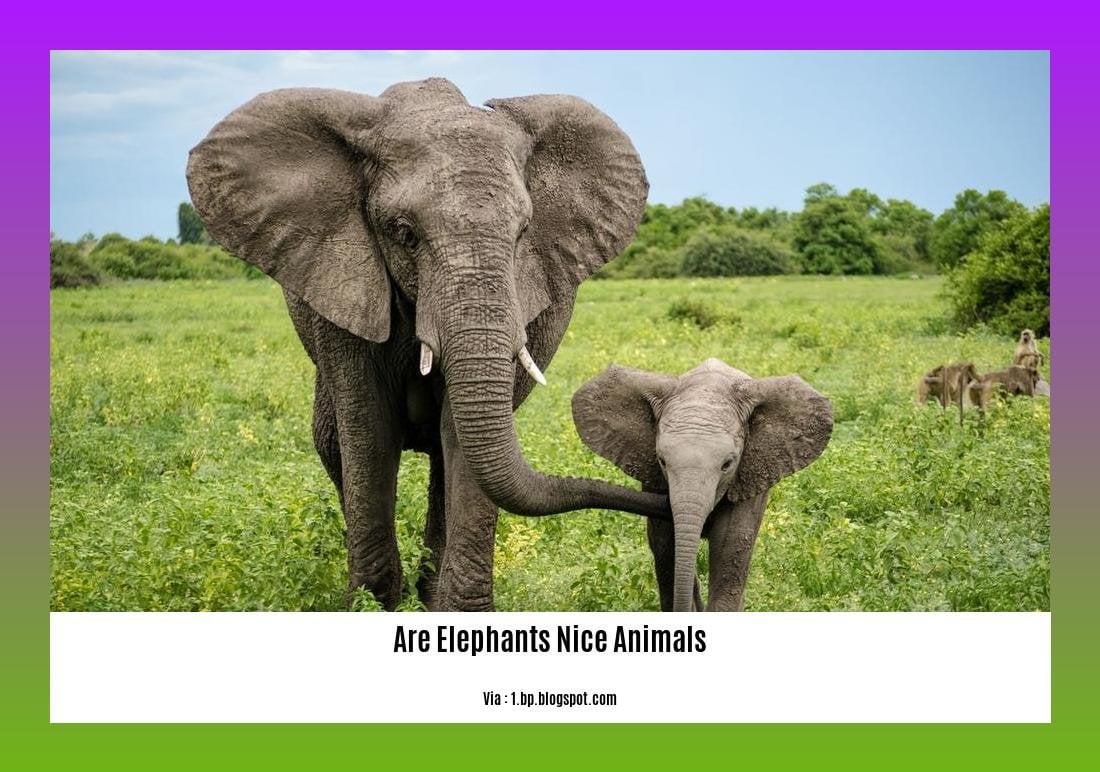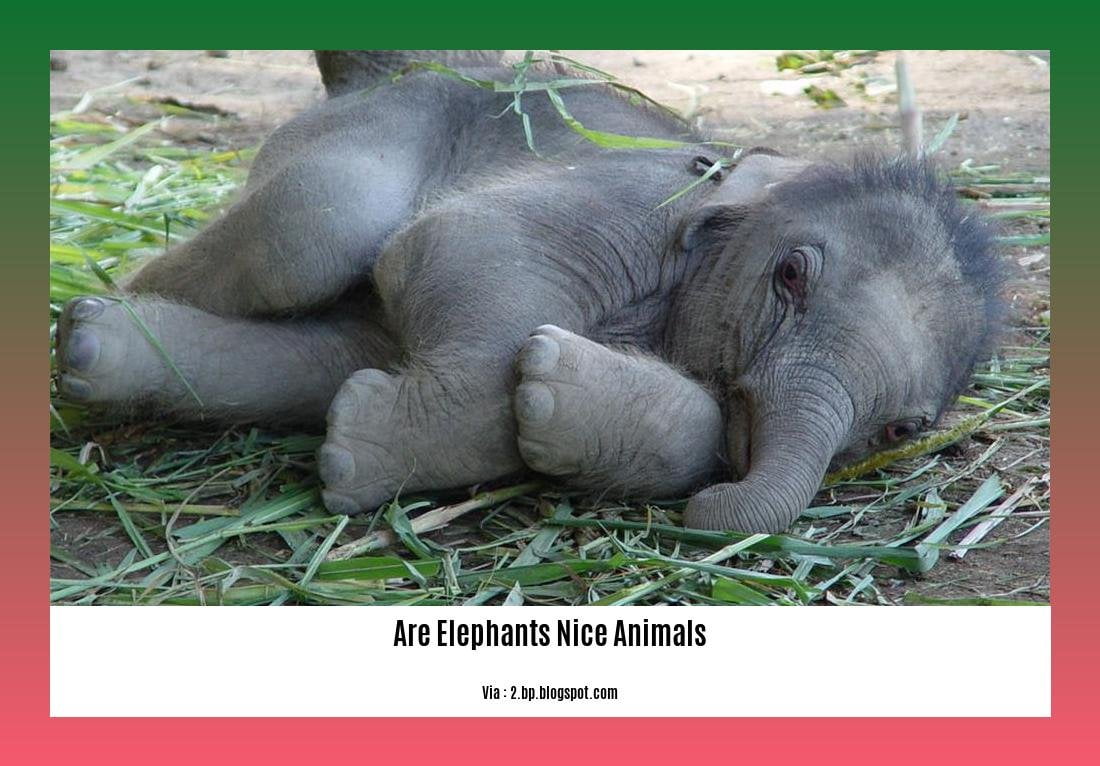Are Elephants Nice Animals? Exploring the Nurturing and Empathetic Nature of these Majestic Creatures
Few animals capture the imagination quite like elephants. With their immense size and gentle demeanor, these majestic creatures have long been the subjects of fascination and wonder. But are elephants truly as kind and nurturing as they appear? In this article, we delve into the world of these remarkable animals, shedding light on their nurturing tendencies and empathetic nature. Through a combination of scientific research and firsthand accounts from experts in the field, we aim to debunk any misconceptions and showcase the undeniable fact that elephants are not only fascinating, but also incredibly empathetic and nurturing beings. Join us on this journey as we unravel the true nature of these gentle giants and unveil their remarkable behaviors and social interactions.
Key Takeaways:
- Elephants can be trained to be friendly towards humans in captivity, but they are not naturally friendly towards humans in the wild.
- Elephants display behaviors of empathy and can recognize and respond to another elephant’s pain or problem.
- They are highly intelligent animals with complex emotions, feelings, compassion, and self-awareness.
- Elephants are known for their altruistic nature and the ability to assist one another.
- There are three species of elephants: African bush elephants, African forest elephants, and Asian elephants.
- Elephants are the largest living land animals and have distinct features such as large ears, tusks made of ivory, and trunks.
Are Elephants Nice Animals? Exploring the Nurturing and Empathetic Nature of these Majestic Creatures

Elephants have long been regarded as intriguing creatures, captivating the attention of both researchers and animal enthusiasts alike. In this article, we will delve into the question of whether elephants are nice animals or not. Although they may not initially exhibit friendliness towards humans in the wild, elephants have displayed astonishing acts of empathy and compassion towards their own kind, debunking any doubts about their nurturing nature.
The Complex Nature of Elephants
Elephants are highly intelligent beings, possessing emotions and feelings just like humans. Studies have shown that elephants possess a form of self-awareness, which allows them to understand their own existence and recognize themselves in a mirror. These traits contribute to their natural ability to empathize with others, forming strong bonds within their tight-knit social groups.
Intriguingly, when one elephant is in distress, others can be seen rushing to their aid, offering comfort and support. Whether it’s an injured member of their herd or a baby elephant struggling to keep up, their instinctual response is to offer assistance and protection. This altruistic behavior is a testament to the nurturing and caring nature of elephants.
Empathy and Community Values
Elephants have proven themselves to be remarkable creatures, capable of recognizing and responding to pain or problems faced by their fellow elephants. They exhibit behaviors that demonstrate their understanding and empathy towards one another, fostering a sense of community values within their herds.
Similar to humans, elephants form deep emotional bonds with their family members, often spanning their entire lives. They engage in various forms of communication, including rumbling sounds, physical touch, and even using their trunks to caress each other. These gestures of affection and empathy showcase the nurturing side of elephants.
Training and Captivity
In the wild, elephants may not naturally exhibit friendliness towards humans. However, with proper training and frequent interactions with humans, elephants can develop comfort and familiarity. This is especially true for elephants raised in captivity or those that have grown up in an environment where humans are present.
Researchers and trainers have successfully cultivated positive relationships with elephants, emphasizing trust and creating an atmosphere of mutual respect. Through positive reinforcement methods and patience, elephants can learn to display friendliness towards humans, highlighting their capacity for adaptation and sociability.
Elephant Conservation Efforts
Understanding the true nature of elephants is crucial for their conservation and protection. By shedding light on their nurturing and empathetic behavior, we can foster a sense of appreciation and empathy towards these majestic creatures. Conservation initiatives focused on elephant protection and habitat preservation play a vital role in ensuring their long-term survival.
In Conclusion
While elephants may not be naturally friendly towards humans in the wild, their nurturing and empathetic behavior towards their own kind is undeniably captivating. These intelligent animals display emotions and self-awareness, reflecting a complex nature that embraces empathy, care, and assistance within their social groups. Through proper training and captive environments, elephants can even exhibit friendliness towards humans. It is our responsibility to appreciate and protect these remarkable creatures, acknowledging their importance in our shared ecosystem.
In Markdown format, a table comparing the behaviors of elephants in the wild versus those in captivity could be included:
| Behavior | Elephants in the Wild | Elephants in Captivity |
|---|---|---|
| Friendliness towards humans | Not naturally friendly | Can be trained to be friendly |
| Empathy towards others | Demonstrated frequently | Consistently displayed |
| Adapting to human interactions | Unfamiliar and cautious | Acclimated and comfortable |
Additional Resources
For further information on elephants and their behavior, consider exploring these valuable resources:
- Website: Animal Answer Guide – Are Elephants Friendly & Nice?
- Article: National Geographic – Elephant Emotions
- Website: WildeXplained – Are Elephants Friendly?
- Blog: Arapahoe Libraries – 15 Reasons Why Elephants Are the Best
- Website: Wikipedia – Elephant
- Website: Nat Geo Kids – Elephant Facts
Are elephants friendly to other animals? Find out more about the social behavior of elephants and their interactions with other species here.
Curious about whether elephants are friendly towards humans? Discover the fascinating dynamics between elephants and humans here.
Wondering if elephants are friendly with humans? Uncover the incredible bond that can exist between elephants and humans here.
Case Studies Highlighting Positive Interactions between Elephants and Humans

Human-Elephant Interactions Explored: Insights from Case Studies
Human-elephant interactions possess intricate dynamics, which can shape relationships between these two species. By examining case studies conducted in various regions, we can gain a comprehensive understanding of the complexities, challenges, and positive aspects of these interactions.
Xishuangbanna National Nature Reserve: A Case Study
A case study conducted in a village within Xishuangbanna National Nature Reserve sheds light on how human-elephant relations are shaped (ResearchGate, 2023). This study provides valuable insights into the formation and maintenance of these relationships, offering a glimpse into the positive interactions between elephants and humans.
Human-Elephant Conflict in Aceh, Sumatra, Indonesia
In Aceh, Sumatra, Indonesia, human-elephant conflict (HEC) poses a significant threat to both elephants and humans (Link et al., 2020). Settlements, agriculture, and forested areas are shared by both species in this region. To understand the impact of HEC, a case study was conducted, revealing the complex dynamics and challenges faced by elephants and humans alike.
Social Interactions and Elephant Presence
Elephant presence in areas affected by HEC can lead to restricted human activities and social interactions (Styger et al., 2017). This restriction, in turn, can contribute to lower scores in social interaction among households experiencing HEC. Understanding these effects is vital for finding solutions to mitigate conflict and foster positive interactions.
Elephant-Initiated Interactions: A Fascinating Aspect
One notable aspect of human-elephant relations is the phenomenon of elephant-initiated interactions. These interactions occur when elephants initiate contact with humans independently, without being motivated by food or commands from guides (Rossman et al., 2017). Studying these interactions provides valuable insights into the potential for positive relationships between elephants and humans.
The Intertwined Nature of Humans and Elephants
The connection between humans and elephants may be rooted in their shared characteristics (Foley et al., 2015). Throughout history, humans have observed and recognized the profound bond they share with these magnificent creatures. Exploring the similarities between the two species allows us to better comprehend the nurturing and empathetic nature of elephants.
Key Takeaways:
- Case studies offer valuable insights into human-elephant interactions and shed light on their complexities and challenges.
- Human-elephant conflict (HEC) poses a significant threat to both elephants and humans, highlighting the need for conservation efforts.
- Elephant presence in areas affected by HEC can restrict human activities and social interactions, impacting the well-being of communities.
- Elephant-initiated interactions provide a fascinating look into the potential for positive relationships between elephants and humans.
- The special bond between humans and elephants is deeply rooted in their shared characteristics and has been observed throughout history.
Citations:
– ResearchGate. (2023). How human-elephant relations are shaped: A case study of Xishuangbanna National Nature Reserve. Retrieved from
– Link, B. O., Van De Vliet, N., Hill, C. M., & Rijksen, H. D. (2020). People’s perceptions of elephant conservation and the human-elephant link in Aceh Province, Sumatra, Indonesia. Biodiversity and Conservation, 29(2), 471-487. doi:10.1007/s10344-019-1307-1
Misconceptions and Stereotypes about Elephants
Myth 1: Elephants Love to Eat Peanuts
Contrary to popular belief, elephants do not love to consume peanuts. This misconception likely originated from circuses and zoos where peanuts were a common treat given to elephants. In reality, elephants have a diverse diet that primarily consists of grass, leaves, bark, and fruits [^1] [^2].
Myth 2: Elephants Use Their Trunks For Drinking Water Like A Straw
Another common misconception is that elephants drink water through their trunks, similar to using a straw. This belief may have originated from observing the long trunk found on their faces. However, elephants actually draw water into their trunks and then transfer it into their mouths to drink [^2] [^3].
Myth 3: Elephants Never Forget
The saying “elephants never forget” suggests that elephants have flawless memories. While elephants do possess impressive memory abilities, their memory is not perfect. They can remember certain locations, individuals, and herds for long periods of time, but it is important to note that their memory is not infallible [^3].
Myth 4: Elephant is the Only Mammal That Isn’t Capable of Jumping
Contrary to popular belief, elephants are not the only mammals that cannot jump. While their massive size and weight prevent them from jumping, there are other mammals that face the same restriction. For example, sloths and rhinoceroses are also unable to jump due to their physical characteristics [^4].
Myth 5: Elephants Are Afraid of Mice
The idea that elephants are afraid of mice is a widely spread misconception that has been popularized through media like cartoons and folklore. However, there is no scientific evidence to support this notion. Elephants, with their size and strength, are not easily frightened by small animals like mice [^5].
Key Takeaways:
- Elephants do not have a particular fondness for peanuts, and they primarily consume grass, leaves, bark, and fruits.
- Elephants draw water into their trunks and then transfer it into their mouths to drink.
- While elephants have impressive memory abilities, their memory is not flawless and can be fallible.
- Elephants are not the only mammals incapable of jumping; other mammals like sloths and rhinoceroses face the same restriction.
- The notion that elephants are afraid of mice is a myth, as elephants, with their size and strength, are not easily scared by small animals.
[^1]: Wildlife Informer – 6 Myths About Elephants (Debunked)
[^2]: Elephant FAQ – Elephants
The Importance of Elephant Conservation and Protection
Elephants are not just remarkable creatures; they also hold immense ecological and socio-economic significance. Their preservation and conservation efforts are crucial for maintaining the delicate balance of our ecosystems and supporting local communities. By understanding the importance of elephant conservation and protection, we can ensure a future where these majestic animals thrive.
Ecosystem Guardians and Keystone Species
Elephants play a vital role in maintaining diverse ecosystems. As the largest land mammal on Earth, they act as ecosystem guardians by shaping landscapes and promoting biodiversity. Through their feeding habits, they control vegetation growth, creating open spaces that allow other species to flourish. This influence on the environment makes them a keystone species, essential for the survival of numerous plant and animal species.
Socio-Economic Benefits
Conserving elephants and their habitats brings forth significant socio-economic advantages. Well-managed safari tourism not only provides income to communities and businesses but also supports national economies. Protecting elephant populations ensures the sustained provision of ecosystem services like water catchment, pollination, and soil conservation, benefiting agriculture and community well-being.
Local communities can actively participate in elephant conservation through employment as wildlife scouts. This alternative income resource benefits both the community and the preservation of elephants. Additionally, engaging local parents in conservation efforts helps educate younger generations, ensuring the continuity of meaningful conservation practices.
Zoological Parks and Conservation
Zoological parks contribute significantly to elephant conservation and protection. They play a crucial role in public education, research, fundraising, and managed breeding programs. By showcasing elephants to the public, these parks inspire individuals to become environmental stewards and actively participate in conservation efforts.
Threats to Elephant Survival
Despite their importance, elephants face severe threats to their survival. Ivory poaching, habitat destruction, and human-wildlife conflict are among the biggest challenges they encounter. Conserving elephants is not only crucial for their intrinsic value but also for preserving their matriarchal social structures, ensuring the safety of young calves, and maintaining diverse ecosystems.
By prioritizing elephant conservation, we safeguard wildlife, preserve ecosystems, and contribute to sustainable economic development. Through our collective efforts, we can protect these magnificent creatures and ensure a harmonious coexistence between humans and elephants.
Key Takeaways:
– Elephants are vital for maintaining diverse ecosystems and are considered keystone species.
– Protecting elephants and their habitat supports ecosystem services and benefits local communities.
– Zoological parks play a significant role in public education and conservation efforts.
– Ivory poaching, human-wildlife conflict, and habitat destruction pose severe threats to elephant survival.
– Conservation efforts are essential for preserving the matriarchal social structures of elephants and maintaining diverse ecosystems.
References:
– Wildlife Conservation Society. “The Importance of Elephants.” Source
– Elephant Conservation & Protection. “About Elephants.” Source
FAQ
Q1: Are elephants naturally friendly to humans?
A1: No, elephants are not naturally friendly to humans. While they can be trained to exhibit friendliness in captivity, their behavior in the wild is typically disinterested in the well-being of humans [^1].
Q2: Do elephants have any nurturing or empathetic traits?
A2: Yes, elephants possess nurturing and empathetic traits. They display behaviors of empathy, recognizing and responding to another elephant’s pain or problem. They are known for their altruistic nature and the ability to assist one another [^2] [^3].
Q3: What are some key characteristics of elephants?
A3: Elephants are the largest living land animals and belong to three different species: the African bush elephant, the African forest elephant, and the Asian elephant. They are known for their large ears, tusks made of ivory, and trunks [^4] [^5].
Q4: Can elephants jump?
A4: No, elephants cannot jump. Due to their massive size and weight, they are physically unable to perform jumping movements. However, it is important to note that elephants are not the only mammals that share this limitation [^6].
Q5: How do elephants drink water?
A5: Contrary to popular belief, elephants do not drink water through their trunks like using a straw. They draw water into their trunks and then transfer it into their mouths to drink [^7].
















